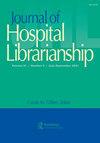Charting Consumer Health: Online Orthopedic Resources
Q3 Social Sciences
引用次数: 0
Abstract
How Americans use the Internet for health-related activities is rapidly changing with the pandemic pushing those changes even further. According to the November 2019 National Telecommunications and Information Administration (NTIA) Internet Use Survey, four out of five Americans use the Internet with more than half of those households reporting using it for health-related activities. These activities include communicating with health professionals, accessing health records, and researching health information (1,2). Pre-pandemic, 43% of health centers could provide telemedicine, compared with 95% of the health centers that reported using telehealth during the COVID-19 pandemic (3). It seems likely that as telehealth visits have increased, patients have become more comfortable using the Internet and participating in online health-related activities. Patients generally feel positive about using the Internet, finding it both time and cost-effective for locating health information. They describe health and social benefits such as improved self-care behavior and better social support (4,5). This also includes an increase in knowledge about orthopedic conditions that Dekkers, et al. found for patients who used the Internet as a source of education (4). Orthopedics is the specialty focused on the musculoskeletal system, treating injuries to bones, joints, ligaments, and tendons. Some common musculoskeletal conditions include bone and joint problems, osteoarthritis, arthritis, back pain, osteoporosis, and fractures. These conditions may be short term or lifelong. Global Burden of Disease (GBD) data showed that approximately 1.71 billion people globally have musculoskeletal conditions with low back pain and osteoarthritis being the most common conditions (6). Patients, parents and guardians often search the Internet prior to upcoming orthopedic consultations or surgery. In a 2019 study, Peterlein et al. found that while approximately half of their participants visited their hospital website to prepare for a visit, many were also visiting less trustworthy sites such as Wikipedia, YouTube, Facebook, and Twitter (7).绘制消费者健康图表:在线骨科资源
随着疫情进一步推动这些变化,美国人如何利用互联网进行与健康相关的活动正在迅速变化。根据2019年11月美国国家电信和信息管理局(NTIA)的互联网使用调查,五分之四的美国人使用互联网,其中超过一半的家庭报告称,他们将互联网用于与健康相关的活动。这些活动包括与卫生专业人员交流、访问健康记录和研究健康信息(1,2)。在大流行前,43%的卫生中心可以提供远程医疗,而在新冠肺炎大流行期间,95%的卫生中心报告使用远程医疗(3)。似乎随着远程医疗访问的增加,患者使用互联网和参与在线健康相关活动变得更加舒适。患者通常对使用互联网感到积极,发现查找健康信息既省时又划算。他们描述了健康和社会效益,如改善自我护理行为和更好的社会支持(4,5)。这也包括Dekkers等人为使用互联网作为教育来源的患者发现的有关骨科疾病的知识的增加(4)。骨科是专注于肌肉骨骼系统的专业,治疗骨骼、关节、韧带和肌腱损伤。一些常见的肌肉骨骼疾病包括骨骼和关节问题、骨关节炎、关节炎、背痛、骨质疏松和骨折。这些情况可能是短期的,也可能是终身的。全球疾病负担(GBD)数据显示,全球约有17.1亿人患有肌肉骨骼疾病,其中腰痛和骨关节炎是最常见的疾病(6)。在即将到来的骨科会诊或手术之前,患者、父母和监护人经常在互联网上搜索。在2019年的一项研究中,Peterlein等人发现,虽然大约一半的参与者访问了他们的医院网站为访问做准备,但许多人也访问了维基百科、YouTube、Facebook和Twitter等不太值得信赖的网站(7)。
本文章由计算机程序翻译,如有差异,请以英文原文为准。
求助全文
约1分钟内获得全文
求助全文
来源期刊

Journal of Hospital Librarianship
Social Sciences-Library and Information Sciences
CiteScore
1.00
自引率
0.00%
发文量
43
期刊介绍:
The Journal of Hospital Librarianship is the first journal to specifically address the issues and concerns of librarians and information specialists in the field of hospital librarianship. This peer-reviewed journal focuses on technical and administrative issues that most concern hospital librarians, providing a forum for those professionals who organize and disseminate health information to both clinical care professionals and consumers. The Journal addresses a wide variety of subjects that are vital to the field, including administrative, technical and program issues that may challenge hospital librarians. Articles published in the Journal focus on research strategies, administrative assistance, managed care, financing, mergers, and more.
 求助内容:
求助内容: 应助结果提醒方式:
应助结果提醒方式:


